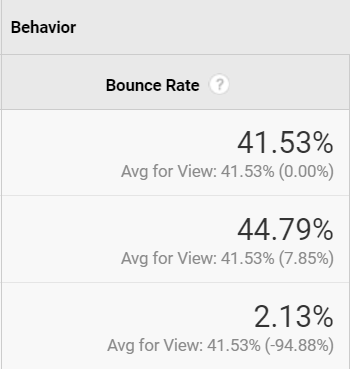
Properly positioning your company on the web is a critical step to acquiring new customers or engaging new users. Whether you have a free movie website, a church website, or a small business web site, it is a fact that most people cannot help but judge a company or service they find on the web within just a few seconds of landing on a page. Having an updated website shows the potential customers that you are in business, whether in person or on the web. It also shows that you are invested into providing your visitors with most up-to-date information, quickly. Ultimately, it results in building an effective business web site.
"I came, I puked, I left" is a very famous quote by Avinash Kaushik, when discussing the bounce rate. But what does it mean precisely? At what point is a bounce being recorded? Is it purely when a visitor hits the back button or is there more to it? And what does the bounce rate of a web page imply? In this post, we will discuss what it is, what it means, and what can be done to improve it.
Before we discuss building an effective business web site, let's discuss the bounce rate.
The bounce rate is a simple metric that measures the percentage of visitors that land on your web site, and do nothing on the page they landed on. This means that they did not engage further by clicking on a menu item, a 'read more' link, or any other internal links on the page. A user is considered bounced when there has not been any engagement with the landing page and the visit ends with a single-page visit. A bounce rate metric can be used to indicate the quality of a website and the target of the audience. Google Analytics is one of the most popular web analytic services to track and report website traffic.
According to Google, the bounce rate is calculated as follows:
Bounce rate is single-page sessions divided by all sessions, or the percentage of all sessions on your site in which users viewed only a single page and triggered only a single request to the Analytics server.
In other words, it records all sessions where a visitor only visited one page and divides it by all sessions.
According to Avinash Kaushik, author of "Web Analytics: An Hour a Day", a bounce rate of under 20% is hard to get. Anything over 35% is a cause for concern and anything above 50% is worrying.
Before we dig any further, it is important to note that Google claims it does not use Google Analytics data as a ranking factor. In essence, it would not be reliable for Google to do so, since an incorrect implementation of Google Analytics will provide inaccurate data - therefore affecting search results.
According to multiple Googlers, Google doesn’t use Google Analytics’ data in their search algorithm. But, of course, when people come from a search engine to a site, they don’t bounce back to the search results, since that kind of bouncing probably is a ranking factor. It is very likely to be measured in a different way than the bounce rate we see in Google Analytics.
From a holistic SEO perspective, every aspect of a web site needs to be optimized. Looking at the bounce rate can help optimize the website - which contributes to search engine optimization.
Determining whether the height of the bounce rate is a good or bad thing generally depends on the purpose of the web page. If the purpose is for informational purposes only, then a high bounce rate is not necessarily a bad thing. Of course, we all prefer for people to stick around and read more articles, subscribe, or perform a click-to-action. But when a visitor only visited the page to read a post or find an address for instance, then it isn't surprising they close the page or hit the back button after reading it. Therefore, it is also important to measure the bounce rate for organic traffic sources and new visitors.
If the purpose of the page is to engage visitors with your site, then a high bounce rate is a bad thing. Let's assume your page has one goal: get visitors to subscribe to your newsletter. If that page has a high bounce rate, then the page needs to be optimized. This can be done by adding a clear call-to-action or subscribe button. If that does not work, then perhaps the web site design or the the web site performance is not acceptable. All of these can lower the bounce rate significantly.
But there can be other reasons for a high bounce rate, of course. If you lured visitors to your website under false pretenses, it is no surprise they when these visitors do not engage with the page. Quality traffic is much more important than volume for high conversion.

By looking at the bounce rate from a conversion perspective, the bounce rate can be used as a metric to measure success. For instance, the design has recently been changed in the hopes it will convert better.
Monitoring the bounce rate will indicate whether the changes were right or wrong. An increase in the bounce rate indicates the changes were not correct for the audience.
This very blog you are reading has actually significantly improved the bounce rate from a re-design by an average of over 35%. The bounce rate for some pages was reduced by as much as 94%.
Another way of looking at the bounce rate, is from a traffic sources perspective. Which traffic sources lead to a high or a low bounce rate? Your newsletter for instance? Or a referral website that sends a lot of traffic?
The only way to lower the bounce rate is improving the engagement on the page(s). A web site refresh or new content is a sure way to attract visitors.
If certain traffic sources have high bounce rates, it is important to know the expectations of the visitors coming to the site. If the source is from an advertisement on another site, and most people coming via that source bounce, then your ad is misleading and not satisfying the visitors. The page is simply not living up to their expectations. Review the ad campaign and ensure that it matches the page and page content.
If your page lives up to the expectations of your visitors, and the page still has a high bounce rate, then you have to look at the page itself. How’s the usability of the page? Is there a call-to-action above the fold on the page? Do you have internal links that point to related pages or posts? Do you have a menu that’s easy to use? Does the page invite people to look further on your site? These are all things you need to consider when optimizing your page.
At QWERTY Concepts, we build websites that build businesses. Schedule a free website assessment and or request a quote for your business web site, today.









